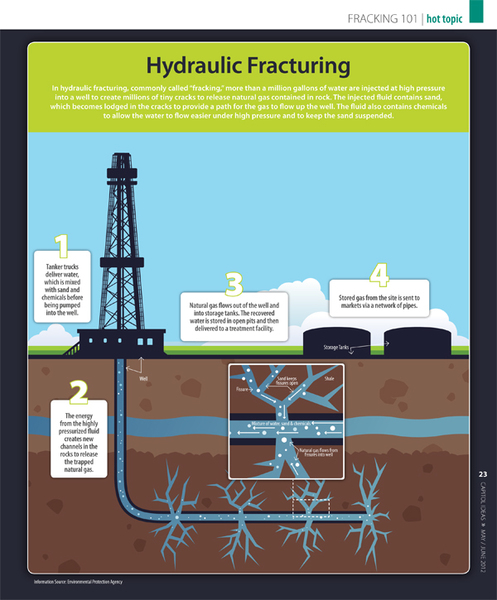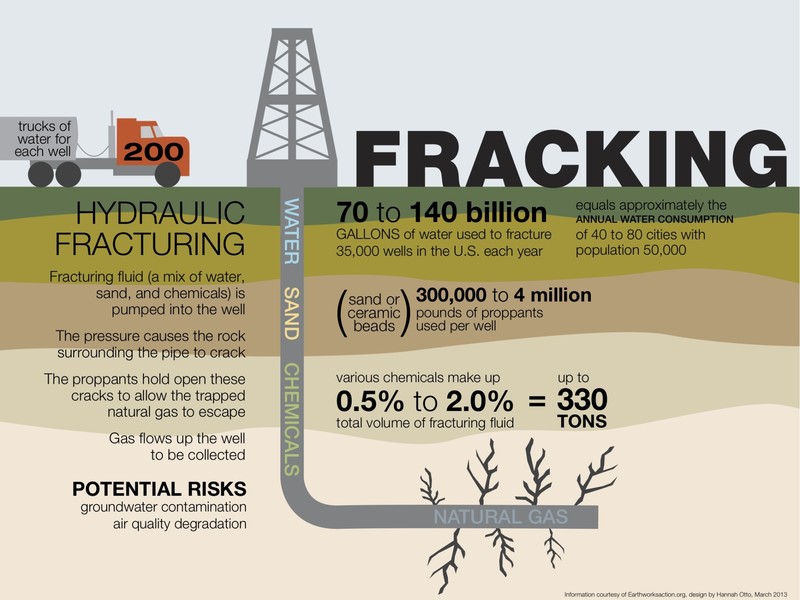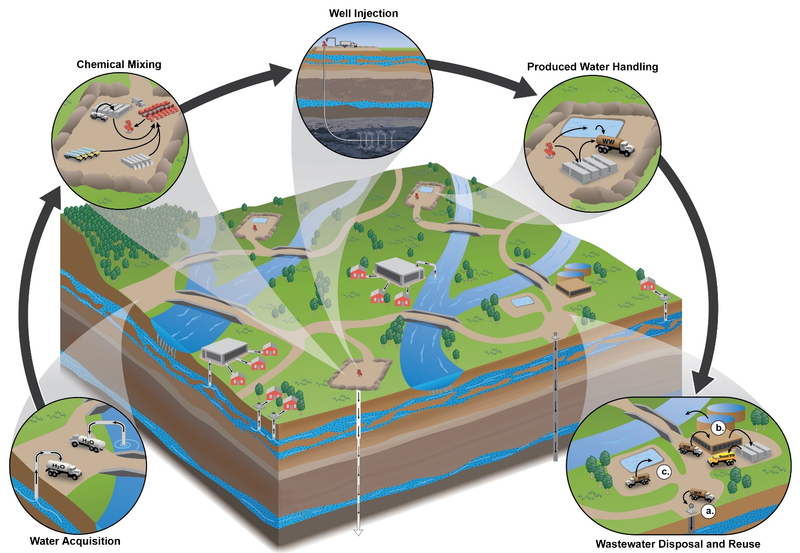_**Hydraulic fracturing (aka fracking or hydrofracking) makes up a growing portion of the energy sector, and the environmental concerns associated with this process are shared among concerned citizens across the world. There are dozens of subtopics associated with the fracking industry, and this wiki is a work in progress. Please contribute to the resources and discussion by [editing this wiki page](https://publiclab.org/wiki/edit/fracking) or [adding and answering questions](https://publiclab.org/wiki/fracking#Questions) below!**_ Follow Fracking ##Questions Questions from the Public Lab community tagged with 'fracking' will appear here [questions:fracking] ##Activities Activities on Public Lab tagged with 'fracking' will appear here [activities:fracking] ##What Is Fracking? **Fracking** is “the process of injecting liquid at high pressure into subterranean rocks, boreholes, etc so as to force open existing fissures and extract oil or gas” ([Here’s the History of Fracking in U.S.](https://www.greenmatters.com/p/history-of-fracking-in-us)). In short, fracking is the extraction of hydrocarbons from rock by fracturing it. ####Unconventional Fossil Fuels Fracking is a method of **“unconventional” fossil fuel extraction**. Compared to “conventional” methods, unconventional oil and gas resources are much harder to extract, often due to poor permeability and porosity of the source rock, and specialized techniques and technologies must be developed to reach these resources. Unconventional fossil fuels include tar sands (which must be mined and then injected with stream), oil shale, shale gas, and deepwater oil. The development of unconventional fossil fuel technologies has many implications. First, because these technologies make previously inaccessible or unretrievable fossil fuels available, the burning of hydrocarbons from unconventional fossil fuel extraction adds carbon dioxide to the atmosphere that would otherwise still be sequestered underground. This threatens the carbon cycle and exacerbates global warming & climate change. Second, the technologies and processes needed for unconventional fossil fuel extraction are costly and resource-intensive. Third, all methods of unconventional fossil fuel extraction have associated environmental concerns and threaten costly environmental damage to fragile ecosystems, leading to social costs borne by the public and the need for land, water, and pollution remediation ([Unconventional Fossil Fuels](https://geographyrevisionalevel.weebly.com/65c-unconventional-fossil-fuels.html#:~:text=6.5C%20-%20Unconventional%20Fossil%20Fuels.%201%20Tar%20Sands.,for%20the%20resilience%20of%20fragile%20environments.%20More%20items)). ####Fracking Fluid The liquid injected into the rock to fracture it is termed “**fracking fluid**” and is a mixture of water, sand, and chemical additives. 99.5% of fracking fluid is water and sand proppant, leaving 0.5% made up by added chemicals. _(Note: other sources say chemicals may make up as much as 2% of the fracking fluid)._ These over 1,000 chemical additives serve numerous purposes, including dissolving minerals, minimizing friction, removing oxygen from the water, killing bacteria, and removing pipe scale ( [Everything You Wanted To Know About Unconventional Fossil Fuel Sources](https://fossilfuel.com/everything-you-wanted-to-know-about-unconventional-fossil-fuel-sources/)). Potentially hazardous chemicals are present in fracking fluid, including methane, ethylene glycol, propargyl, lead, and benzene ([23 Fracking Statistics Everyone Should Know in 2021](https://seedscientific.com/fracking-statistics/)). ####Shale Rock Fracking is used to extract oil and gas from **shale**, a type of sedimentary rock that accounts for about 70% of the rock in Earth’s crust ([Shale Rock: Geology, Composition, Uses](https://www.thoughtco.com/shale-rock-4165848)). It is a fine-grained rock made from compacted mud and clay known for its ability to break into layers (a characteristic known as **fissility**). Shale formations generally have low permeability, meaning fluids (like oil and gas) do not flow easily through them (indicating the necessity for fracking to break the rock apart). Shale has widespread commercial uses, including the production of bricks, pottery, tiles, & some cement and of course the extraction of oil & gas. ####What Types of Oil and Gas Are Produced From Fracking? + **Shale (or tight) oil**: type of oil that may be extracted by heating and upgrading kerogen trapped in shale ([Shale oil - Energy Education](https://energyeducation.ca/encyclopedia/Shale_oil)). + **Kerogen** is a substance that forms when shale is heavily buried and heated. It releases oil and natural gas slowly when it is continually heated ([Kerogen - Energy Education](https://energyeducation.ca/encyclopedia/Kerogen)). + **Tight gas**: natural gas trapped within a rock with extremely low permeability (typically limestone or sandstone) + _Note: tight gas is typically found in limestone or sandstone, NOT shale_ + **Shale gas**: natural gas trapped within shale ([Shale gas - Energy Education](https://energyeducation.ca/encyclopedia/Shale_gas)). ####Process [](/i/45086?s=o) _Image courtesy of [Guide to Human-Made Earthquakes in Idaho](https://wp.wwu.edu/guide/2017/12/01/hydraulic-fracturing-fracking-the-basics/)_ 1. Water is mixed with sand and chemicals 2. A well is drilled into the shale and sealed to prevent groundwater contamination 3. Horizontal drilling may or may not take place 4. Perforating gun sends explosive charges to puncture holes deep in the shale 5. Highly pressurized fracking fluid is pumped into the well 6. Energy from the pressurize fracking fluid cracks shale open at tiny holes -- “Fracturing” occurs when the pressure of the fluid exceeds the tensile strength and the least principal stress of the rock. 7. Fracking fluid is pumped out, now called “produced water”, and (ideally) natural gas or oil will follow. 8. Repeat (maybe)---the same well can be fracked up to 20 times Overall, fracking creates permeability in rocks, allowing pores naturally filled with hydrocarbons to enter the man-made maze of cracks connected to the well. ####History Hydraulic fracturing has been used in the United States since the 1940s, with some sources saying the “first” instance of fracking occurred as early as the 1860s. The process was first used in Kansas on limestone, and since then, 1.7 million wells have been created and more than 7 billion barrels of oil and 900 trillion cubic feet of natural gas have been produced. ####Argued Benefits of Fracking The Independent Petroleum Association of America lists some benefits of utilizing fracking technology in their statement: “By safely unlocking America’s abundant natural resources, fracking has created millions of American jobs, reduced energy prices, brought cleaner air by significantly reducing U.S. greenhouse gas emissions to 25-year-lows, strengthened our national security, and transformed the United States into a global energy superpower." #Environmental Issues Associated With Fracking Fracking is an extremely resource-intensive process. Each frack requires up to 8 million gallons of water and 40,000 gallons of chemicals. With 1.7 million wells and up to 20 fracks per well, that’s 272 trillion gallons of water and 1.36 trillion gallons of chemicals since 1947. [](/i/45087?s=o) _Image courtesy of [Americans Against Fracking](https://sites.psu.edu/fracking1/)_ ####Water Unconventional methods of fossil fuel extraction require more water than conventional methods, and fracking is no exception. [](/i/45088?s=o) _Image courtesy of [US EPA](https://www.epa.gov/hfstudy/hydraulic-fracturing-water-cycle)_ ####Methane - According to the NRDC, by 2025 health damages caused by methane leakage during fracking are estimated to be at $13-29 billion/year. - [Methane in water](https://www.youtube.com/watch?v=4LBjSXWQRV8) ####Land & Soil “Since unconventional fossil fuels are more difficult to access, they demand more energy and occupy more land. They also produce more waste” ([Everything You Wanted To Know About Unconventional Fossil Fuel Sources](https://fossilfuel.com/everything-you-wanted-to-know-about-unconventional-fossil-fuel-sources/)). ####Air ####Frac Sand Mining #####Water Contamination #####Mine reclamation #####Radon ####Distraction From Renewables Many of the benefits of fracking---lower gas prices and increased national energy security due to wider availability of fossil fuels---disincentivizes the shift toward renewable energy resources that is necessary to mitigate climate change. ####Earthquakes ####Greenhouse Gas Emissions While natural gas is considered the “cleanest” fossil fuel, it is composed of 80% methane. During the fracking process, about 3.7% of the natural gas is released into the atmosphere (known as the leakage rate). Methane’s global warming potential is 84 times that of CO2 because it lasts in the atmosphere so much longer, meaning over time methane contributes more to global warming and climate change ([23 Fracking Statistics Everyone Should Know in 2021](https://seedscientific.com/fracking-statistics/)). ##Environmental Justice Issues ##Banning Fracking ##Human & Public Health Concerns ##Fracking Rhetoric ##Boots on the Ground: Community Groups, Individuals, Nonprofits, & Researchers ##Resources & Further Reading - [Here's the History of Fracking in U.S.](https://www.greenmatters.com/p/history-of-fracking-in-us) - [Unconventional Fossil Fuels](https://geographyrevisionalevel.weebly.com/65c-unconventional-fossil-fuels.html#:~:text=6.5C%20-%20Unconventional%20Fossil%20Fuels.%201%20Tar%20Sands.,for%20the%20resilience%20of%20fragile%20environments.%20More%20items) - [Fracking explained: opportunity or danger](https://youtu.be/Uti2niW2BRA)...
| Author | Comment | Last activity | Moderation | ||
|---|---|---|---|---|---|
| maxikavitha | "The project is very nice and waiting to know more. " | Read more » | over 2 years ago | |||
| noah_ben_furman | "I am excited for us to create our project page! " | Read more » | over 2 years ago | |||
| JuliaGuerrein | "Excited to work on this project as the Environmental Policy Fellow! " | Read more » | over 2 years ago | |||
| stevie | " @stevie has marked @bee as a co-author. " | Read more » | over 2 years ago | |||
| stevie | " @stevie has marked @bee as a co-author. " | Read more » | over 2 years ago | |||
| stevie | " @stevie has marked @bee as a co-author. " | Read more » | over 2 years ago | |||
| stevie | " @stevie has marked @bee as a co-author. " | Read more » | over 2 years ago | |||
| ferian084 | "residence inn breakfast hours " | Read more » | about 3 years ago | |||
| stevie | " @stevie has marked @pat as a co-author. " | Read more » | over 3 years ago | |||
| yonte | "Zula Archeological Site Eritrea travel would never be complete without visiting the archeological sites of Adulis and Zula. Zula is a small town on..." | Read more » | almost 4 years ago | |||
| ef_aka_ave | "Nice info bro! Appreciate it! " | Read more » | almost 4 years ago | |||
| clippingpathbest | "Clipping Path Best is a well reputed photo editing service company ,Here you can find any type of photo editing service with affordable price and a..." | Read more » | almost 4 years ago | |||
| amocorro | "Curious about past Public Lab workshops on frac sand environmental concerns? Check out this 2019 post from @joyofsoy https://publiclab.org/notes/jo..." | Read more » | almost 4 years ago | |||
| joyofsoy | "We got this response on Twitter: Try to set it on fire?https://t.co/tWmJr26diI— Josh Levinger (@jlev) November 6, 2019 " | Read more » | about 5 years ago | |||
| satnam95895 | "Samosarecipe.com was share knowledge related samosa recipe " | Read more » | about 5 years ago | |||
| warren | "Linking back to issue I made from this: https://github.com/publiclab/leaflet-environmental-layers/issues/50 " | Read more » | about 6 years ago | |||
| warren | " " | Read more » | over 6 years ago | |||
| warren | " " | Read more » | over 6 years ago | |||
| warren | "@liz - you know some OpenStreetMap folks, do you know if this is an OK use of the API in terms of how often we'd query? " | Read more » | over 6 years ago | |||
| warren | "I found that there is a landuse=landfill tag, from https://wiki.openstreetmap.org/wiki/Map_Features Using that, I made a query on this page: http:..." | Read more » | over 6 years ago | |||
| warren | "The landfill is shown on OpenStreetMap! https://osm.org/go/TYrX7hdN- " | Read more » | over 6 years ago | |||
| warren | "@xose @imvec @sarasage - I'm really interested in how these layers can help inform and support local environmental projects. I noticed that if you ..." | Read more » | over 6 years ago | |||
| Mylespadelhi01 | "Its really very nice! " | Read more » | over 6 years ago | |||
| stevie | "Looks great! Could the layers also have a pop-out that explain what they are, where they are from and where people can learn more when you click on..." | Read more » | over 6 years ago |